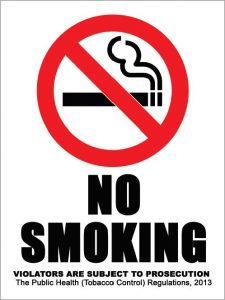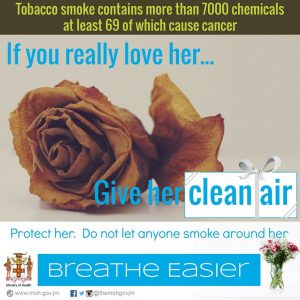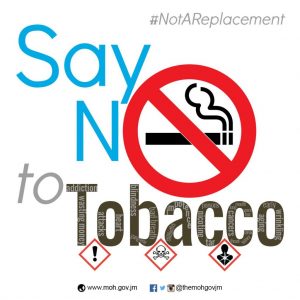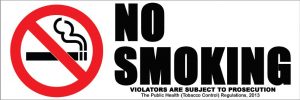Navigation
- WHO Framework Convention on Tobacco Control
- Protection from exposure to tobacco smoke
- Regulation of tobacco product disclosures
- Packaging and labelling of tobacco products
- Report Breaches of tobacco control legislation
- Preventing Tobacco Industry Interference
WHO Framework Convention on Tobacco Control
- Measures relating to the reduction of demand for tobacco
- Measures relating to the reduction of supply of tobacco
- Implementation of the WHO FCTC
The World Health Organization Framework Convention on Tobacco Control (WHO FCTC) is the first treaty negotiated under the auspices of the World Health Organization. The WHO FCTC is an evidence-based treaty that reaffirms the right of all people to the highest standard of health. The WHO FCTC represents a paradigm shift in developing a regulatory strategy to address addictive substances; in contrast to previous drug control treaties, the WHO FCTC asserts the importance of demand reduction strategies as well as supply issues.
The WHO FCTC was developed in response to the globalization of the tobacco epidemic. The spread of the tobacco epidemic is facilitated through a variety of complex factors with crossborder effects, including trade liberalization and direct foreign investment. Other factors such as global marketing, transnational tobacco advertising, promotion and sponsorship, and the international movement of contraband and counterfeit cigarettes have also contributed to the explosive increase in tobacco use.
As at June 15, 2016, a total of 180 countries have become parties to the WHO FCTC . Jamaica has been a party since July 7, 2005. As with other international treaties, being a party means that in addition to having a moral obligation for the protection of health, the government is legally bound to implement the treaty’s provisions.
The Parties to this Convention, determined to give priority to their right to protect public health, have committed to protect present and future generations from the devastating health , social, environmental and economic consequences of tobacco consumption and exposure to tobacco smoke. The Convention provides a framework for tobacco control measures which are intended to reduce continually and substantially the prevalence of tobacco use and exposure to tobacco smoke. To achieve this objective, the framework includes provisions which addressing both the demand and supply of tobacco products.
Measures relating to the reduction of demand for tobacco
The core demand reduction provisions in the WHO FCTC are contained in articles 614:
- Price and tax measures to reduce the demand for tobacco, and
- Nonprice measures to reduce the demand for tobacco, namely:
- Protection from exposure to tobacco smoke;
- Regulation of the contents of tobacco products;
- Regulation of tobacco product disclosures;
- Packaging and labelling of tobacco products;
- Education, communication, training and public awareness;
- Tobacco advertising, promotion and sponsorship; and,
- Demand reduction measures concerning tobacco dependence and cessation
Measures relating to the reduction of supply of tobacco
The core supply reduction provisions in the WHO FCTC are contained in articles 1517:
- Illicit trade in tobacco products;
- Sales to and by minors; and,
- Provision of support for economically viable alternative activities.
Implementation of the WHO FCTC
In Jamaica’s Vision 2030, the Ministry of Health was indicated to be the lead Ministry for implementation of tobacco control legislation. In 2013, the Minister of Health, pursuant to Section 14 and 15 of the Public Health Act, effected the Public Health (Tobacco Control) Regulations, 2013. In the main, the Regulations represent the legislative measures needed to implement 3 of the 7 core non price demand reduction provisions of the WHO FCTC:
- Protection from exposure to tobacco smoke – Article 8;
- Regulation of tobacco product disclosures – Article 10;
- Packaging and labelling of tobacco products – Article 11
Document Downloads
Reports on Implementation
- Needs assessment for implementation of the WHO Framework Convention on Tobacco Control in Jamaica January 2015
- A Review of Excise Taxes on Cigarettes In Jamaica February 2015
Useful Links
- Text of the World Health Organization, Framework Convention on Tobacco Control
- Guidelines for Implementation of the WHO Framework Convention on Tobacco Control
- Guidelines for Implementation of Article 6 Price and tax measures to reduce the demand for tobacco
- Parties to the WHO Framework Convention on Tobacco Control
Protection from exposure to tobacco smoke
- Smokefree Spaces
- Going Further
- Optional Exceptions
- “No Smoking” Signage
- Restrictions on Sale
- Private Residences Give – Clean Air
Smokefree Spaces
there is no safe level of exposure to tobacco smoke
The Public Health (Tobacco Control) Regulations, 2013 includes specific requirements for the protection of workers, children, and you from exposure to tobacco smoke.
Rationale Tobacco smoke contains a deadly mix of more than 7,000 chemicals. More than 250 of these chemicals are toxic and at least 69 can cause cancer. There is no safe level of exposure to tobacco smoke.
Given the dangers of breathing in secondhand and tobacco smoke, protection from tobacco smoke is implicit in the right to life and the right to the highest attainable standard of health.
Given the dangers, no worker must be exposed to tobacco smoke in the course of performing their duties. Given the risks, no child should be subjected to having to breathe in these chemicals. Consequently, the Regulations seek to offer protections to these vulnerable groups, as well as the general public.
List of places where smoking is prohibited:
The Regulations therefore prohibit smoking or holding a lit or electronic tobacco product in:
- Enclosed Public Places
- Enclosed Workplaces
- Public Conveyances; and
- Any of the following places (even if they are not enclosed)
- government occupied buildings
- health facilities (including pharmacies)
- sports, athletic or other similar facilities (for the use of the public)
- educational institutions
- bus stops and departure and arrival waiting areas at a port or station for any form of transportation
- areas specifically for use by children
- Staff residences and guesthouses
- Beaches
- Outdoor dining and service areas
- Parks
- National Heritage Sites
- Swimming Pools (Designated as Class A and Class B under the Public Health (Swimming Pools) Regulations, 2000. With the exception of pools for private use or where a pool is exclusively accessible for an independent or private villa or suite)
- Outdoor Markets
- Other outdoor events or activities, being used for gathering by individuals
The 5 metre protective buffer
Smoking or holding a lit or electronic tobacco product is also prohibited within 5 metres (16 feet 5 inches) of all:
- entrances,
- exits,
- windows and
- ventilation intakes
of any of the above named mentioned places.
For clarity, the law defines enclosed as follows:
“Enclosed” means – having a ceiling or roof or a cover which functions as a ceiling or a roof; OR being surrounded or closed off by one curved wall, or on two or more sides by walls or enclosures which function as walls.
Note: Electronic Nicotine Delivery Systems, such as E-Cigarettes, are explicitly included in these prohibitions.
Going Further
The Ministry of Health encourages managers, owners or lessees of premises to choose to go even further than the Regulations require. Therefore, the Public Health (Tobacco Control)(Amendment) Regulations, 2014 adds the provision “nothing in this regulation shall prevent a manager, owner or lessee of premises from prohibiting smoking anywhere else on their premises.”
The manager, owner or lessee just needs to post “No Smoking” signs and advise individuals of the additional prohibitions they choose to implement on their premises.
Optional Exceptions
Outdoor Smoking Areas
The Regulations allow proprietors to establish outdoor smoking areas, provided they can, and have met specified conditions related to the area’s design and location; prohibited activities allowed therein; and control of access to the area.
Note: Proprietors are NOT required to establish outdoor smoking areas
Where a proprietor opts to establish an outdoor smoking area, ALL of the following conditions MUST be met:
Design and Location
All such areas shall be:
- be open sided no walls, no sides, no form of enclosure
- where covered by a roof, have only such columns as are necessary to support the roof;
- be located at a distance of at least ten metres from any structure or area where smoking is prohibited; (10 metres is equivalent to 32 feet 10 inches)
- be located in an area where access by persons, other than those smoking, is not necessary; e.g. it must be located at least 10 metres away from walkways and areas of entertainment
- be physically separated and structurally unconnected to, areas where smoking is prohibited.
Prohibited Activities
In these areas there shall be no:
- distribution, promotion, branding or sale of tobacco products; or
- form of entertainment, organized by the proprietor,
Control of Access
The operator or proprietor shall ensure that:
- no child is permitted to enter, or stay in, any area described therein;
- users of the area are advised that staff do not serve in the area;
- smoking is prohibited altogether in the area, when it is being cleaned or otherwise serviced by staff.
Note: Owners and operators of businesses may ONLY establish outdoor smoking areas IF ALL 10 of these conditions are met.
Balconies of Tourist Establishments
Generally, smoking is prohibited on the balconies of the guest rooms of tourist establishments. However, proprietors of such establishments MAY determine exceptions, provided such guest room balconies do not exceed 10 per cent of the room stock e.g. in a hotel with 100 rooms, ONLY in 10 rooms may smoking be allowed on the balconies.
In addition, the following other conditions MUST be met.
Proprietors of tourist establishments shall further ensure exempted guest room balconies:
- 1. are not served by ventilation units for
- any room designated for use by non-smoking guests; or
- b. any other area where smoking is prohibited;
- are located on a block of rooms, which does not include any adjoining room designated for use by non-smokers;
- are completely, physically separated and unconnected from every other area where smoking is prohibited; and
- are barred from entry into or use by minors.
“No Smoking” Signs
General requirements
Managers, owners or lessees of the places where smoking is prohibited are required to Post “No Smoking” signs prescribed by the Regulations:
- at eye level
- in a prominent position at EACH entrance
- in at least one other prominent place
“No Smoking” Signs, as prescribed by the Regulations, shall be posted AT EYE LEVEL:
- in a prominent place at EACH entrance (including service entrances)
- in at least one other prominent place
The above represents the minimum signage requirements. As signage is critical to compliance, Managers, owners or lessees Proprietors are encouraged to go beyond these minimum requirements in order to ensure compliance (particularly in areas where breaches are noted).
Requirements for Tourist Establishments
The Public Health (Tobacco Control)(Amendment) Regulations, 2014 prescribes in the case of a manager, owner or lessee of a tourist establishment, the “No Smoking” signs shall be placed at –
- the reception area;
- the entrances to all other main buildings; and
- all dining areas, of the tourist establishment.
*The Public Health (Tobacco Control)(Amendment) Regulations, 2014 gives managers, owners or lessees of premises the option to use either presentation of the “No Smoking” sign included in the Regulations.
Public Conveyances
(e.g. buses, taxis, trains, staff transport)
Managers of public conveyances “No Smoking” signs, as prescribed by the Regulations, shall be prominently displayed in each compartment of Public Conveyances. The sign should be at least 76mm x 229mm in size.
Size of “No Smoking” Signs
“No Smoking” signs must be:
- at least 216mm x 279mm (the size of a letter sized sheet of paper) OR
- at least 76mm x 229mm in size.
Note: these are the minimum sizes for the signs. Larger signs are allowed and encouraged.
Downloads
“No Smoking” signs

- Minimum size: 216mm x 279mm
Click here to download
- Minimum size: 76mm x 229mm
Click here to download
Guidance Materials – Protection from Exposure to Tobacco Smoke:
Restrictions on Sale
The Regulations prohibit the sale of Tobacco within a FIVE meter radius of the perimeter of the following places where smoking is prohibited –
- Health facilities
- Sports, athletics or other similar facilities for use by the public
- Government occupied buildings
- Childcare facilities and Educational institutions
Private Residences - Give Clean Air
The Regulations, as amended in 2014, does not legislate protections in private residences. However, the Ministry of Health strongly encourages householders to Protect your household workers, children and spouses Do not let anyone smoke in your home.

Give Clean Air
- Give Clean Air Flyer – Household Workers
- Give Clean Air Flyer – Children
- Give Clean Air Flyer – Spouse
- Give Clean Air Digital Signage Video
Regulation of tobacco product disclosures
Required disclosures from the tobacco industry
The Public Health (Tobacco Control) Regulations, 2013, includes requirements for manufacturers, importers, and exporters of tobacco products to make disclosures to the Minister of Health. These requirements for reporting are key to the Government’s capacity to monitor the extent of the tobacco epidemic and produce data needed to inform further tobacco control measures. Manufacturers, importers, and exporters of Electronic Nicotine Delivery Systems (ENDS) such as E-Cigarettes are subject to these requirements.
This is one of the core non price demand reduction measures implemented by the Regulations relates to Article 10 of the FCTC Regulation of tobacco product disclosures.
Reporting Templates and procedures
Annual Reports
Pursuant to the Public Health (Tobacco Control) Regulations, 2013, ALL manufacturers, importers and exporters of tobacco products are required to annually disclose the following information to the Minister of Health:
- Business name and address
- contact information of –
- the principal place of business; and
- each manufacturing facility, importing warehouse and in-house laboratory services.
- the locations of all distribution offices; and the transportation units, including fleet and licence numbers.
- National Sales Volumes
- the brands sold or distributed to each customer and the pricing of each brand;
- the distribution and supply chain;
- the prices for each stock-keeping unit of tobacco product;
Manufacturers, importers and exporters of tobacco products reports should be made using the:
Other Reports
Ingredients
The Regulations also require manufacturers to provide information on ingredients used, by:
- Product type and for each brand within a brand family
- Quantities of each ingredient per unit of each tobacco product
- Characteristics of tobacco leaves used
Product characteristics
At the request of the Minister, manufacturers and importers shall:
- Disclose information on design features including the results of tests conducted by the industry
- Submit laboratory reports on tests measuring design features (with proof of accreditation of the laboratory)
- Notify the Minister of any change to design features, and submit the updated information advising when the change was effected
Packaging and labelling of tobacco products
- Requirements
- Prohibitions
- Graphic Health Warnings
- Sale of Single Sticks and E-Cigarettes
- Rotation of Health Warnings
Many people are not fully aware of, misunderstand or underestimate the risks for morbidity and premature mortality due to tobacco use and exposure to tobacco smoke. Graphic health warnings and messages on tobacco product packages have been shown to be a cost effective means to increase public awareness of the health effects of tobacco use and to be effective in reducing tobacco consumption. Effective health warnings and messages, and other tobacco product packaging and labelling measures are key components of a comprehensive, integrated approach to tobacco control.
Consequently, the Public Health (Tobacco Control) Regulations, 2013 includes specific requirements for the packaging and labelling of tobacco products in Jamaica. In particular, it requires the inclusion of graphic health warnings covering at least 60% of the principal display surfaces of on tobacco product packaging.
Requirements
Packs of tobacco products The labels of ALL tobacco products, including cigarettes, cigars, bidis, tobacco wraps, chewing tobacco, etc, which are intended for retail sale in Jamaica, MUST. Note the placement of 7 of the 10 are explicitly stated.
Therefore, on the Principal Display Panels MUST appear: A Graphic Health Warning
The graphic health warning shall be printed on the package itself and not on the cellophane or detachable outer packaging or by adhesive labels or similar means; be reproduced from the electronic files used to generate the health warnings specified in Parts III, IV and VII of the first schedule of the Regulations; be reproduced in at least four colours
The required files are available from the Ministry of Health:
Other requirements
Other Requirements for Principal Display Panels
On the Principal Display Panels MUST also appear:
- The common name of the goods, e.g. ‘cigarettes’, ‘cigars’, ‘bidis’
- The trade name or brand
- The net contents (e.g. the count of units or volume)
On the side panels of rectangular packages
- The prescribed declaration (for smoked tobacco products)* the Background of declaration may either be yellow or white. For cartons, the declaration area is permitted to be located on any side
On the side Opposite the declaration must appear
- The Manufacture date (in the format mm (or mmm) yyyy
- The Batch Number The manufacture date and batch number shall be printed in black on a white background or by means of contrasting colours surrounded by a 0.5mm thick black border and in a type size of no more than 2mm.
*For rectangular packages, the declaration area shall be the full side panel, except that for flip top packages, the declaration area shall be the portion of the side panel which is lower than the flip top opening
Requirements for which location is not specified
The following are required to be on each pack, however, placement is not specified.
- The following statement – “Sale only allowed in Jamaica”
- The name and complete address of manufacturer
- The name and complete address of distributor*
*If the tobacco product is manufactured in Jamaica, and the manufacturer acts as its own distributor the name and complete address may be listed just once.
Prohibitions
The Regulations PROHIBIT the following markings on packaging:
- Best before, expiry, sell by, or any similar date
- Packaging that in any way promotes the product by any means that is false, misleading, deceptive, or likely to create an erroneous impression about the products characteristic, health effects, hazards, or emissions
Also prohibited are misleading descriptors such as
- light;
- ultra light;
- Ultra;
- mild;
- low tar;
- Slim;
- Extra; or
- Any other similar words or descriptions; manufacturers are prohibited from using:
- Any graphics or package design characteristic associated with; or likely, or intended to be associated with any misleading descriptor
- a number to differentiate brands within a brand family;
- a number associated with a smoking machine yield
Graphic Health Warnings
Smoked Tobacco Products
Set A Health Warnings
- Pack
- Carton
Set B Health Warnings
- Pack
- Carton
Smokeless Tobacco Products
Set A Health Warnings
Set B Health Warnings
Distribution of Graphic Health Warnings
ALL eight health warnings from the relevant set, must as far as reasonably practicable, be evenly distributed within every case of stock-keeping units.
Each case must exclusively contain health warnings from the select set. Therefore, it is not allowed for a case to contain health warnings from both SET A and SET B.
Sale of Single Sticks and E-Cigarettes
Consumers must be made aware of the risks of using any product they acquire, even if unpackaged. Therefore, if you sell individual single sticks of tobacco, or electronic nicotine delivery systems (such as ecigarettes), you are required to prominently display a sign/poster bearing one of the applicable health warnings from the Public Health (Tobacco Control) Regulations, 2013. Each such health warning shall be at least 216mm x 279mm.
Rotation of Health Warnings
World No Tobacco Day precedes each cycle of exclusive use of a set of Graphic Health Warnings.
Breaches of the tobacco control legislation
If you observe breaches ofthe Public Health (Tobacco Control) Regulations, 2013 and other Tobacco Control laws, advise of us about it. Note: Issues that require immediate attention should be reported directly to the police. Use our online reporting tool – Click here.
Or contact your parish health department.
Preventing Tobacco Industry Interference
FCTC Article 5.3
“In setting and implementing their public health policies with respect to tobacco control, Parties shall act to protect these policies from commercial and other vested interests of the tobacco industry in accordance with national law.”
Notifications of interactions
The following are notices of interactions with the Tobacco Industry


